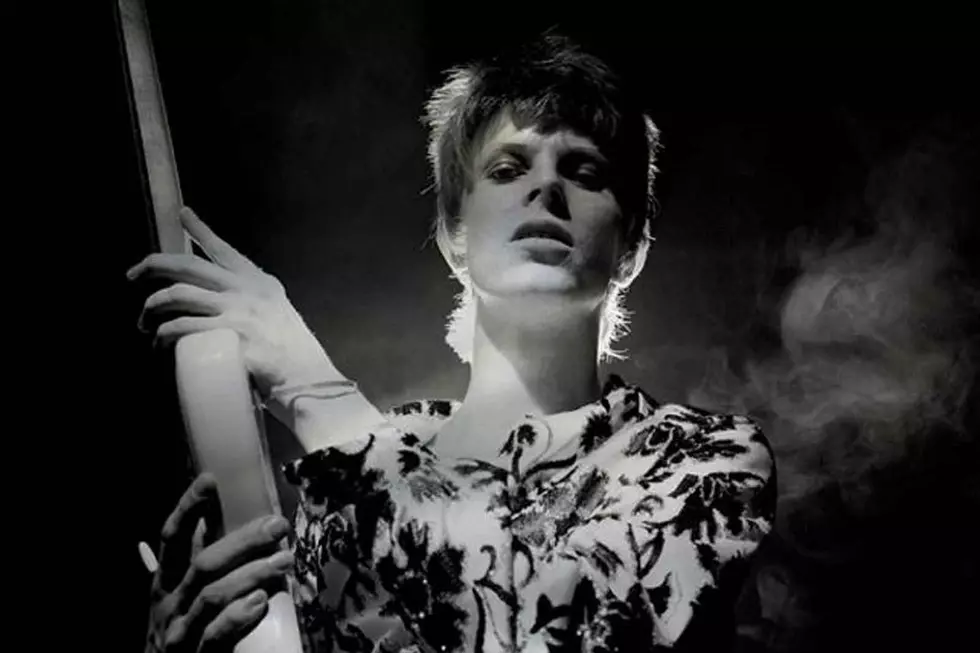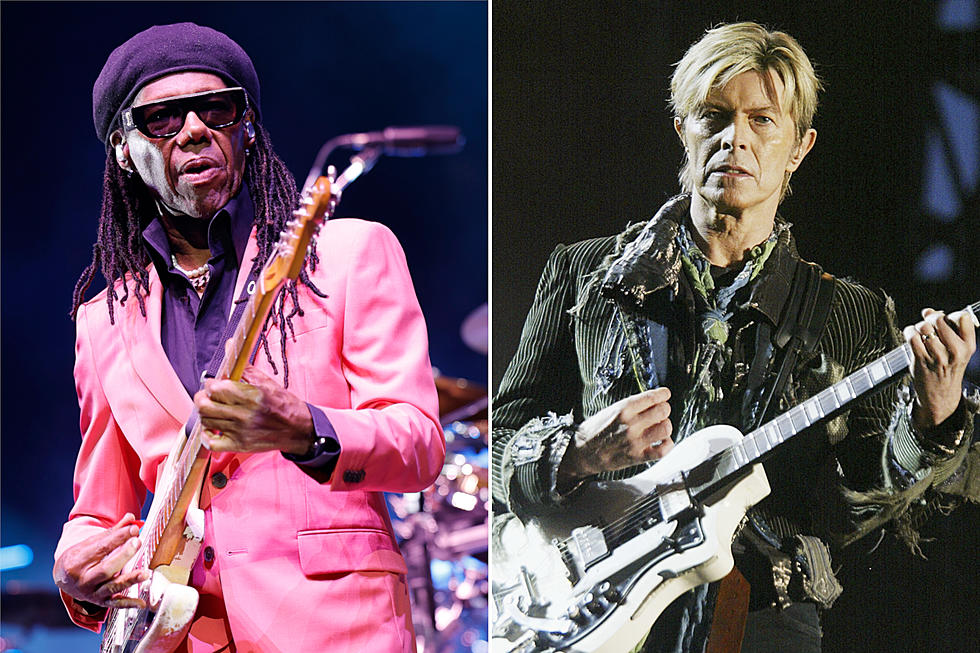
The History of David Bowie and Tin Machine
By the end of 1987, David Bowie had been a superstar for 15 years. Mentioned in the same breath as Madonna, Michael Jackson and Bruce Springsteen, he was a very wealthy man with hit albums, movie roles and top-grossing concert tours.
However, the sheen of pop stardom faded after the mega-excess of the Glass Spider tour. "Being shoved into the Top 40 scene was an unusual experience," Bowie admitted during an interview with the Orlando Sentinel at the time. "It was great I'd become accessible to a huge audience ... but not terribly fulfilling." The tour was financially in the black, but the reviews from critics were harsh, causing Bowie to question the authenticity of his music and the nature of superstardom. He wasn’t interested in being a greatest-hits singer, but was eager to reinvent himself once again.
The creation of Tin Machine, with Bowie as lead singer, would be the path to his reinvention. And although the band released only two studio albums – the first of which was released on May 22, 1989 – and one live album in its brief lifespan, Tin Machine became David Bowie’s musical redemption.
The group, as Christopher Sanford wrote in Bowie: Loving the Alien, was created as "a way for Bowie to purge his past while making his usual deft assault on the market." The first part of that statement certainly turned out to be accurate. Bowie teamed up with Reeves Gabrels, Hunt Sales and Tony Sales to form a band where every member was equal. Favoring jamming with each other versus having a songwriter bring in lyrics and a demo for the group to learn, Tin Machine were a cathartic experience for all involved.
The Sales brothers were part of Iggy Pop’s Lust for Life tour with Bowie, while Gabrels was a relatively recent musical partner Bowie met during the Glass Spider tour. Together, they were ready to create music that weaved in their influences from the ‘60s to the ‘80s. Bands like Cream, the Pixies and Jimi Hendrix were all mentioned as key influences in Tin Machine’s sound. And from the opening track of their record, the bluesy "Heaven’s in Here," it’s clear that a kind of British interpretation of blues was part of the group’s sound; a sound that was grittier than most rock bands in the music business at the time.
Listen to Tin Machine's 'Under the God'
Even the way the album was recorded (live takes, few overdubs, and no finessing the lyrics), was at odds with production standards of the day. "We’re very much a live unit ... and we’ve had to contour the recording studio to suit our live approach," Gabrels noted in a CD-single interview packaged with Under the God. "It took a certain leap of faith on the part of the engineers to trust us in the way we wanted to record. They kind of looked at us funny because we all wanted to play at the same time and David wanted to sing [while we played] which is generally not done anymore."
The band relished its unorthodox approach and the creative freedom this process produced, ignoring the modern rules of recording. The result was an unvarnished, proto-grunge sound that had Gabrels’ screeching, yet melodic, guitar at one end, the Sales brothers adding deep, rhythmic foundations of drums and bass on the other. Bowie remained at the center, an angry middle-aged man.
Tin Machine’s sound was ahead of its time. As such, when the band made its 1989 debut, the general reaction seemed to be collective confusion. Rolling Stone, MTV and Melody Maker all gave Tin Machine fairly positive press, but the majority of the media simply savaged the group. Many of Bowie’s fans were not pleased with the music, either. Few knew what to make of a bearded Bowie simply serving as a singer in a hard rock band. Bowie’s label EMI hated what they heard, and tried to shop his contract to other labels after the release of the album.
Even the tour was the antithesis of the globe-trotting, stadium-filling Glass Spider-era Bowie. Playing just 12 dates, the band was booked into small venues that were a boon for Bowie fans wanting to see the rock star up close, but a bust for those hoping to hear his hits. Tin Machine was only playing their music – rare covers included songs by John Lennon and Bob Dylan – and the songs were explosive, raw, and angry: Lyrics like "Toxic jungle of Uzi trails / Tribesmen just wouldn't live here / Fascist flare is fashion cool / Well, you're dead, you just ain't buried yet" couldn't have been more jarring for fans of recent hits like "Let’s Dance" and "Blue Jean."
Listen to Tin Machine Perform 'Heaven's In Here'
Critic Alastair McKay provided a typically acidic broadside, reviewing a Tin Machine performance for the Herald Scotland in 1989. "For all their experience, the band are poor timekeepers, and Bowie's voice is at sea with the very notion of high-volume aggression. ... [T]he grinning Bowie promised his group would return to repeat the experience in the new year. This raised just one question: Why?"
That said, Bowie’s hardcore fans didn’t stay home from the Tin Machine tour. Tickets sold out at most concert halls, and the singles "Under the God" and "Heaven’s in Here" both peaked in the Top 20 in the Alternative Album chart in the U.S.
However, album sales were very low – with some estimates stating that only 200,000 units of their debut record sold by the time the group broke up in 1991. As a point of contrast, sales for Never Let Me Down were more than 500,000 in the U.S. in 1987 alone. EMI was losing money on Tin Machine and they wanted out. By 1990, EMI got its wish when Bowie and the label went their separate ways.
Clearly, the price of purging the sterile sounds of the ‘80s came at a tremendous financial cost to Bowie. He was becoming cash poor, but enjoying a rich creative period musically. To keep himself financially aloft and continue to pursue his passion with Tin Machine, he had to essentially give the people what they wanted. He released the Sound+Vision box set and embarked on a tour, which he marketed by saying that it would be the last time he ever performed his back catalog.
The strategy worked. The Sound+Vision box set sold very well and ticket sales surpassed even the Serious Moonlight tour in 1983. Being in the Top 40 may not have been terribly fulfilling, as Bowie said in 1987, but it made him extremely rich again as a new decade began.
Watch David Bowie on 1990's 'Sound+Vision' Tour
In 1991, Bowie was ready to get Tin Machine together again. The positive experience of making the first project was too infectious for Bowie to abandon at this point, and anticipation was at an all-time high. In fact, as the band was preparing to release Tin Machine II on Sept. 2, 1991, they were introduced as "the future of rock 'n' roll" at a press-event concert. "It may sound like ridiculous hype – it may, in fact, be ridiculous – but there is a touch of truth about that statement," said Rolling Stone's David Wild, who covered the event.
Unfortunately, Tin Machine II didn't mark the future, but the beginning of the end. Many of the songs on the second album were written and recorded in Australia after the Tin Machine’s first tour, and the band was eager to finish the project in Los Angeles, release the album via the newly formed Victory Records and start another round of shows. Hunt Sales ended up taking lead vocals on a pair of the L.A. tracks, "Sorry" and "Stateside."
That wasn't the only signal that this record would be very different from its predecessor. Gabrels was suddenly favoring atmospherics rather than melody. Songs like "Baby Universal" found the guitarist seemingly off in his own world, while Bowie and the Sales brothers settled into a more conventional song structure – perhaps to keep things from veering too far off course.
Tin Machine II had none of the anger, the immediacy, or the power of the debut album. The band lost the sliver of a plot they created in 1989, and now they sounded too conventional for the times. Rolling Stone, despite Wild's earlier claims, even turned on the album – saying it "bogs down with turgid songs ... and filler" as part of a withering two-star review. Even the album cover, featuring four nude Grecian-style male statues, sparked negative reactions. The U.S. version of 'II' would arrive with their genitals airbrushed over. To make matters worse, Nirvana’s Nevermind would be released three weeks later, changing the musical landscape for good.
Watch Tin Machine Perform 'Baby Universal'
The tour was very similar to the band’s first outing in that it featured small venues and no-frills stage sets, but they added more dates. The reaction this time around wasn't so much hostile as it was simply bored: "Bowie and his associates gave a more than hour-long display of his latest incarnation," Joel Selvin wrote for the San Francisco Chronicle. "And the music turned out to be nearly unlistenable." A concert souvenir from the tour, titled Tin Machine Live: Oy Vey, Baby, failed to chart in either the U.S. or the U.K.
Next came the inevitable statement from Bowie: Tin Machine were breaking up, he said, citing "personal problems in the band." There was a lesson there, Sanford said in Bowie: Loving the Alien, for future collaborators with the chameleon-like Bowie: "By 1994, the Sales brothers had learnt what literally dozens of musicians had found out before them: a collaboration with Bowie was no lifetime guarantee."
Whatever conflicts there were within the group, and whatever their commercial struggles, Bowie offers no regrets – principally because Tin Machine reinvigorated him at a point in which he desperately needed it.
"I look back on the Tin Machine years with great fondness," Bowie told Uncut. "They charged me up. I can’t tell you how much. Reeves shook me out of my doldrums, pointed me at some kind of light – said, ‘Be adventurous again.’ I’ve been finding my voice, and a certain authority, ever since."
David Bowie Albums Ranked
More From Ultimate Classic Rock









